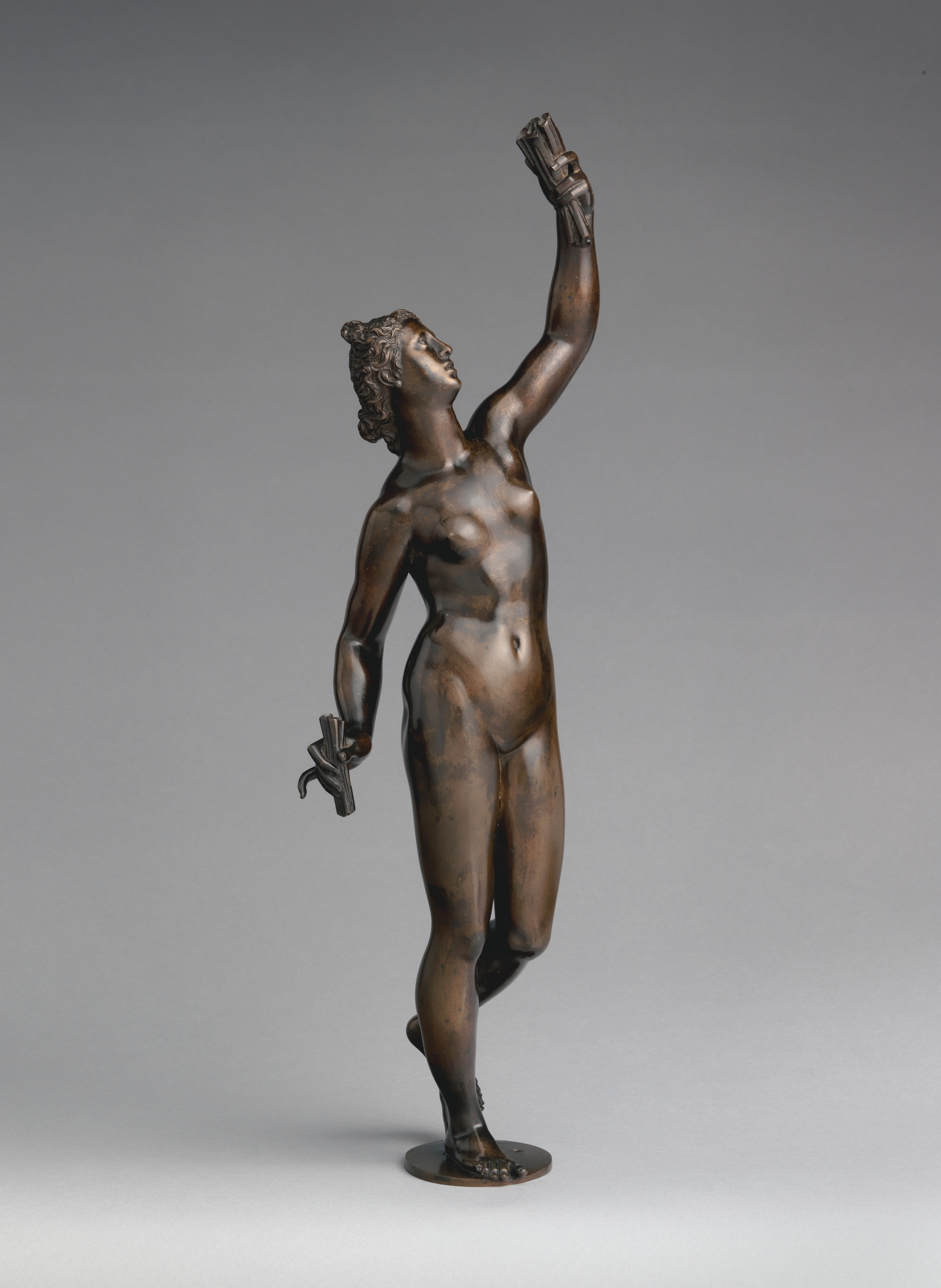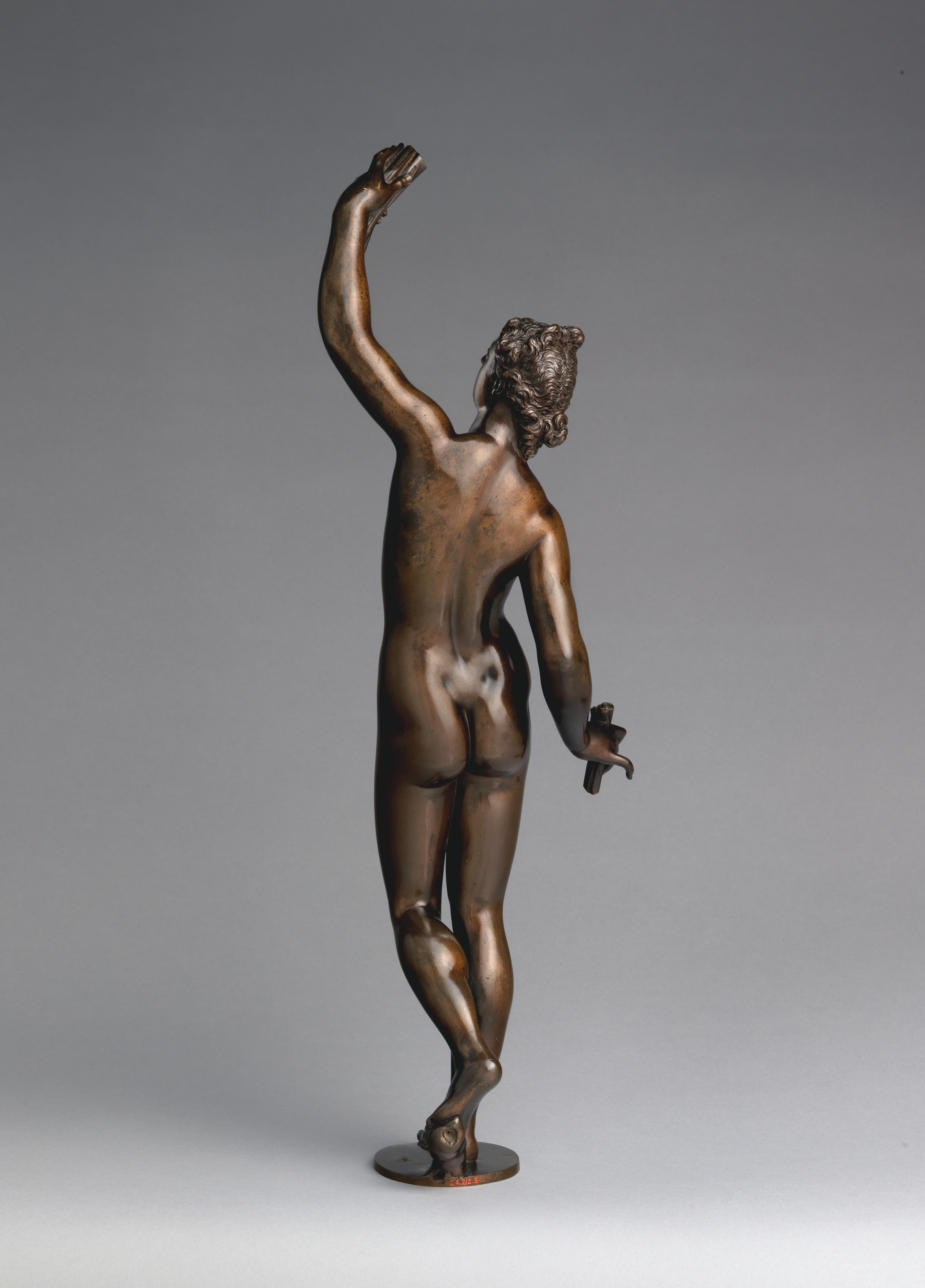Fortuna
After a model by Giambologna Netherlandish
Possibly by Antonio Susini Italian
When this statuette came to The Met in 1924 as part of the Mills bequest, curator Joseph Breck described it as a “beautiful bronze of about 1550, representing Venus Marina,” and assigned it to Danese Cattaneo. Breck’s opinion would have rested on precedents set by German scholars Wilhelm von Bode and Leo Planiscig. The latter, for example, associated Cattaneo with a similar composition in Vienna: a graceful figure holding in her hands the ends of a billowing sail, her feet poised on a sphere carried on the foamy waves of a choppy sea (fig. 122a).[1] For a number of bronzes adopting this scheme or elements of it, including the present statuette, subsequent scholarship shifted both attribution and subject, from Cattaneo and Venus Marina to Giambologna’s followers and Fortuna.
Archival discoveries published in the 1970s confirm the existence of a now-lost Fortuna model in Giambologna’s repertory.[2] The chain of evidence begins in 1609 in the collection inventory of Giambologna’s executor Benedetto Gondi, which records a bronze Fortuna by the master’s hand.[3] Then, in 1612, a Fortuna was among the fifteen bronzes comprising a diplomatic gift to Henry, prince of Wales, from Cosimo II de’ Medici. Correspondence exchanged throughout 1611 specifying the terms of this commission indicates that Pietro Tacca was assigned the task of casting copies of Giambologna’s most celebrated models, among these “La fortuna.” Seven of the models, including the Fortuna, were borrowed from the Salviati family and designated as “by the hand of [Antonio] Susini” after Giambologna’s prototypes. Both Tacca and Susini had collaborated with Giambologna, and it is reasonable to assume that Susini adopted the older sculptor’s primo pensiero for his own version of the Fortuna. All the casts in the diplomatic gift can be traced through the 1639 inventory of Charles I’s collection, which provides a fuller description of the Fortuna as “a standing woeman wth her left hand over her head, and the other [hand] downe to hould a fortune vale [veil]” and “A Woeman houlding upp her left hand, and her right hand downe, in them, The Vaile of Fortune rent.”[4]
The Renaissance iconography of Fortuna would have been known to Giambologna through sources such as Andrea Alciati’s Emblemata (1551), in which Fortuna appears with Mercury in a woodcut pitting human inventiveness (in the guise of Mercury) against the hazards of chance (Fortuna).[5] Here, her lithe body is posed in a slight S-curve, both arms raised with fingers clutching a wind-blown sail and one foot balanced on a sphere set on a rocky outcrop next to a storm-tossed sea.[6] Charles Avery notes that among the corpus of Fortuna bronzes, the full complement of iconographic elements is rare; in particular, the fluttering sail or veil is “torn away,” reduced to truncated rolls of cloth held in the figure’s hands.[7] These abbreviated casts include the present statuette, another in The Met (cat. 123), one at Stanford and in the Louvre, and two offered at auction in the 2010s.[8] The carefully finished nubs of cloth in all of these works are clearly original to the composition. Avery infers the existence of a complete model during Giambologna’s lifetime that included the arching veil. Perhaps we should also infer, based on the 1639 inventory, which describes Fortuna’s veil as “rent” (torn), that Susini created the abbreviated variant. Or, alternatively, that Tacca dispensed with the veil in his copy of Susini’s version.
Among the many replicas, Watson and Avery consider The Met and Stanford bronzes the closest examples to Giambologna’s workshop production, assigning both to Susini; Bertrand Jestaz makes the same case for the Louvre statuette.[9] Of particular note in style and treatment are the lustrous finish and the exquisite rendering of details such as the curly hair and definition of the irises. These three casts, plus the two sold at Sotheby’s, have similar dimensions (ca. 46–47 cm) that exceed by several centimeters the two-thirds of a braccio (ca. 39 cm) recorded in documents for the Salviati/Susini Fortuna (and thus for Tacca’s copy sent to Prince Henry), suggesting the possibility of a separate series executed on a larger scale. The use of a thin disk as a base is unknown in Giambologna’s autograph works, but can be found in compositions subsequent to his signed creations.
Certain technical irregularities, discovered through radiography, raise questions about the attribution of our bronze to Susini. The use of drawn-wire transfixing core pins and a pourable plaster core are not features of Giambologna’s workshop practice, and the transparent brown patina, although more typical of Florentine bronzes, appears to have been applied later.[10] Nonetheless, for stylistic reasons—in particular the lucid polish and the meticulous rendering of decorative details—Susini’s authorship can be sustained, without ruling out the possibility that our Fortuna is a later derivation of the Tuscan sculptor’s model, as is the case for the cast made by Tacca and sent to England.
-TM
Footnotes
(For key to shortened references see bibliography in Allen, Italian Renaissance and Baroque Bronzes in The Metropolitan Museum of Art. NY: The Metropolitan Museum of Art, 2022.)
1. Planiscig 1921, p. 412, figs. 432, 433.
2. The following discussion is indebted to Watson and Avery 1973.
3. “Una Fortuna di bronzo”; “opere . . . di mano . . . del Cavalier Giovanni Bologna.” Corti 1976, p. 633.
]4. Millar 1960, pp. 92, 211.
5. Watson and Avery 1973, fig. 15.
6. Watson and Avery 1973, pp. 502–3, suggest that Giambologna created the Fortuna as a companion to his Mercury, the earliest of which dates to about 1563–65. In the 1609 Gondi inventory, the entry for a Fortuna directly follows that for a Mercury; see Corti 1976, p. 633.
7. C. Avery and Radcliffe 1978, p. 70, cat. 16.
8. Cantor Arts Center, Stanford University, 1962.235; Louvre, OA 10598; ex-Michael Hall collection, Sotheby’s, London, December 7, 2010, lot 63; ex-French royal collection (inventory no. 236), Sotheby’s, Paris, December 11, 2019, lot 15.
9. Watson and Avery 1973, pp. 502–3; Jestaz 1978.
10. R. Stone/TR, March 11, 2011. Stones believes the bronze was cast in northern Italy; see his essay in this volume, p. 35.
Due to rights restrictions, this image cannot be enlarged, viewed at full screen, or downloaded.
This artwork is meant to be viewed from right to left. Scroll left to view more.




